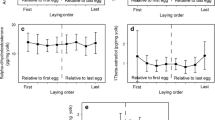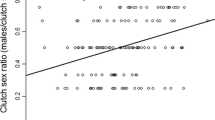Abstract
In birds, many aspects of male socio-sexual and parental behavior are influenced by androgens, most notably testosterone (T). We report the effects of subcutaneous T-implants in male barn swallows (Hirundo rustica) on male and female parental behavior and on seasonal reproductive success. Males were assigned to one of three experimental groups: (i) implanted with a T-filled Silastic tube; (ii) implanted with an empty Silastic tube; and (iii) not implanted. T-implanted males provided a smaller proportion of feedings (number of feedings by the male/total number of feedings by both parents) and fed nestlings less frequently (number of feedings/h) than males of the other two groups. Females paired to T-implanted males fed nestlings significantly more often than females paired with unimplanted males. Females almost fully compensated for their mates' shortfall, and this resulted in similar combined feeding efforts among treatments. Reproductive success in their first broods or during the entire breeding season was unaffected by T- treatment. These results confirm earlier reports of the suppressive effects of T on male parental behavior. However, they are inconsistent with current ESS models that predict partial compensation as the optimal response by one individual to reduction of parental effort by its mate in monogamous, biparental systems.
Similar content being viewed by others
References
Adler NT (ed) (1981) Neuroendocrinology of reproduction: physiology and behavior. Plenum, New York
Alatalo RV, Gottlander K, Lundberg A (1988) Conflict or cooperation between parents feeding nestlings in the pied flycatcher Ficedula hypoleuca (Pallas). Ornis Scand 9:31–34
Balthazart J (1983) Hormonal correlates of behavior. In: Farner DS, King JR, Parkes KC (eds) Avian biology, vol 7. Academic Press, New York, pp 221–365
Chase ID (1980) Cooperative and noncooperative behavior in animals. Am Nat 115:827–857
Falconer DS (1981) Introduction to quantitative genetics. 2nd edn. Longman, New York
Folstad A, Karter AJ (1992) Parasites, bright males, and the immunocompetence handicap. Am Nat 139:603–622
Grossman CJ (1985) Interactions between the gonadal steriods and the immune system. Science 227:257–261
Hegner RE, Wingfield JC (1987) Effects of experimental manipulation of testosterone levels on parental investment and breeding success in male house sparrows. Auk 104:470–480
Houston AI, Davies NB (1985)The evolution of cooperation and life history in the dunnock, Prunella modularis. In: Sibly R, Smith R (eds) Behavioural ecology: the ecological consequences of adaptive behaviour. Blackwell, Oxford, pp 471–487
Ketterson ED, Nolan V Jr (1992) Hormones and life histories: an integrative approach. Am Nat 140:S33-S62
Ketterson ED, Nolan V Jr, Wolf L, Ziegenfus C (1992) Testosterone and avian life histories: effects of elevated testosterone on behavior and correlates of fitness in the dark-eyed junco (Junco hyemalis). Am Nat 140:980–999
Knobil E, Neill JD (1988) The physiology of reproduction, vols 1 and 2. Raven, New York
Møller AP (1988) Female choice selects for male sexual tail ornaments in the monogamous swallow. Nature 322:640–642
Møller AP (1990) Effects of an haematopahgous mite on the barn swallow (Hirundo rustica): A test of the Hamilton and Zuk hypothesis. Evolution 44:771–784
Møller AP (1991) Sexual selection in the monogamous barn swallow (Hirundo rustica). I. Determinants of tail ornament size. Evolution 45:1823–1836
Møller AP (1992) Females prefer large and symmetrical ornaments. Nature 357:238–240
Møller AP (1994) The barn swallow and sexual selection. Oxford University Press, Oxford
Moore MC (1984) Changes in territorial defense produced by changes in circulating levels of testosterone: a possible hormonal basis for mate-guarding behavior in white-crowned sparrows. Behaviour 88:215–226
Nolan V Jr, Ketterson ED, Ziegenfus C, Cullen DP, Chandler CR (1992) Testosterone and avian life histories: experimentally elevated testosterone delays postnuptial molt in male dark-eyed juncos. Condor 94:364–370
Oring LW, Fivizzani A, El Halawani ME (1989) Testosterone-induced inhibition of incubation in the spotted sandpiper (Actitis macularia). Horm Behav 23:412–423
Saino N, Møller AP (1994) Secondary sexual characters, parasites and testosterone in the barn swallow Hirundo rustica. Anim Behav, in press
Saino N, Møller AP (1995) Testosterone correlates of mate guarding, singing and aggressive behaviour in male barn swallows Hirundo rustica. Anim Behav, in press
Saino N, Møller AP, Bolzern AM (1995) Testosterone effects on the immune system and parasite infestations in the barn swallow (Hirundo rustica): an experimental test of the immunocompetence hypothesis. Behav Ecol, in press
Saino N, Møller AP (1995) Effect of anti-androgen treatment on socio-sexual behavior of male barn swallows (Hirundo rustica). Submitted to Behav Ecol Sociobiol
SAS Institute (1985) SAS user's guide: statistics, version 5 edn. SAS Institute, Cary
Sasvari L (1986) Reproductive effort of widowed birds. J Anim Ecol 55:553–564
Schleussner G, Dittami JP, Gwinner E (1985) Testosterone implants affect molt in male European starling. Physiol Zool 58:597–604
Searle SR (1987) Linear models for unbalanced data. Wiley, New York
Secreto G, Toniolo P, Barrino F, Recchione C, Cavalleri A, Pisani P, Totis A, Fariselli G, Di Pietro S (1991). Serum and urinary androgens and risk of breast cancer in postmenopausal women. Cancer Res 51:2572–2576
Silver R, Ball GF (1989) Brain, hormone and behaviour interactions: status and prospectus. Condor 91:966–978
Silverin B (1980) Effects of long-acting testosterone treatment on free-living pied flycatchers, Ficedula hypoleuca, during the breeding period. Anim Behav 28:906–912
Svensson L (1984) Identification guide to European passerines, 2nd edn. Svensson, Stockholm
Trobec RJ, Oring LW (1972) Effects of testosterone propionate implantation on lek behavior of sharp-tailed grouse. Am Mid and Nat 87:531–536
Wada M (1981) Effects of photostimulation, castration, and testosterone replacement on daily patterns of calling and locomotory activity in Japanese quail. Horm Behav 15:270–281
Wada M (1982) Effects of sex steroids on calling, locomotory activity, and sexual behaviour in castrated male Japanese quail. Horm Behav 16:147–157
Wada M (1986) Circadian rhythms of testosterone-dependent behaviors, crowing and locomotory activity, in male Japanese quail. J Comp Physiol A 158:17–25
Watson A, Parr R (1981) Hormone implants affecting territory size and aggressive and sexual behaviour in red grouse. Ornis Scand 12:55–61
Wingfield JC (1984) Androgens and mating systems: testosterone-induced polygyny in normally monogamous birds. Auk 101:665–671
Wingfield JC, Farner DS (1975). The determination of five steroids in avian plasma by radioimmunoassay and competitive protein-binding. Steroids 26:312–327
Wingfield JC, Ball GF, Dufty AM Jr, Hegner RE, Ramenofsky M (1987) Testosterone and aggression in birds. Am Sci 75:602–608
Winkler DW (1987) A general model for parental care. Am Nat 130:526–543
Wolf L, Ketterson ED, Nolan V Jr (1990) Behavioural response of female dark-eyed juncos to the experimental removal of their mates: implications for the evolution of male parental care. Anim Behav 36:1601–1618
Wright J, Cuthill I (1989) Manipulation of sex differences in parental care. Behav Ecol Sociobiol 25:171–181
Zuk M, Thornhill R, Ligon JD, Johnson K (1990) Parasites and mate choice in red jungle fowl. Am Zool 30:235–244
Author information
Authors and Affiliations
Rights and permissions
About this article
Cite this article
Saino, N., Møller, A.P. Testosterone-induced depression of male parental behavior in the barn swallow: female compensation and effects on seasonal fitness. Behav Ecol Sociobiol 36, 151–157 (1995). https://doi.org/10.1007/BF00177791
Received:
Accepted:
Issue Date:
DOI: https://doi.org/10.1007/BF00177791




